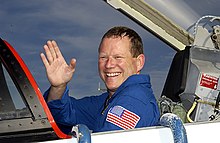David mcdowell brown
David McDowell Brown (April 16, 1956 - February 1, 2003) was a captain in the United States Navy and a NASA astronaut.
Biography
Born in Arlington, Virginia, David Brown was single and prior to his position as an astronaut he served as a stunt performer for college at Circus Kingdom. Brown died in the space shuttle Columbia tragedy on February 1, 2003 over the southern United States 16 minutes before the scheduled landing time.
Education
Graduated from Yorktown High School in Arlington, Virginia in 1974; He received a BS in biology from the University of William and Mary in 1978 and an MD from the Eastern Virginia Medical School in 1982.
Organizations
President of the International Military Association of Medical Pilots. Associate of the Aerospace Medical Association. United States Navy Physician Society.
Special Honors
1986 Navy Flight Surgeon of the Year, Service Merit Medal, and the Navy Achievement Medal.
Experience
Brown enlisted in the Navy after his internship at the University of Southern California Medical College. After completing his flight surgeon training in 1984, he enrolled at the Navy Hospital in Adak, Alaska as Director of Medical Services. In 1988, he was the only flight surgeon in a 10-year period to be chosen for pilot training. He was finally designated as a Naval Aviator in 1990 in Beeville, Texas, making number one in his class. Brown was then sent to training in an A-6E Intruder. In 1991, he reported to the Naval Warfare Center in Fallon, Nevada, where he served as a Lead Attack Training Instructor and as a Contingency Planning Officer.
Brown also qualified in the McDonnell Douglas F/A-18 Hornet and served in Japan aboard the USS Independence flying the A-6E with VA-115. In 1995, he reported to the Naval Test Pilot School as its flight surgeon where he also flew the Northrop T-38 Talon.
Brown has logged more than 2,700 flight hours with 1,700 in high-level military flights. performance. He also qualified as NASA's first T-38 pilot.
NASA experience
Brown was selected by NASA in April 1996, Brown joined the Johnson Space Center in August 1996. Having completed two years of training and evaluation, he was already qualified for the flight assignment as a mission specialist. He was initially assigned to assist in the development of the International Space Station, followed by the support team of astronauts responsible for orbiter cockpit preparation, crew positioning, and landing recovery.
His first and only trip into space was on the STS-107 Columbia mission (January 16 – February 1, 2003). This 16-day mission was dedicated to scientific research, to which he was assigned 24 hours a day in two alternating shifts. The crew successfully carried out nearly 80 experiments. The mission ended in tragedy when the Space Shuttle Columbia disintegrated during reentry over the skies of the southwestern United States with only 16 minutes to go before landing. The cause of this tragedy originated on launch day when a piece of insulating foam from the External Tank detached and damaged the lower part of the Orbiter's left wing, tearing off some thermal protection tiles. On the day of reentry, the absence of these tiles caused the internal structure to overheat, causing destabilization and consequently disintegration of the ship, killing its 7 crew members. Brown logged about 15 days, 22 hours, and 20 minutes in space.
Contenido relacionado
Jerry Seinfeld
Wilfredo gomez
Astrophysics
